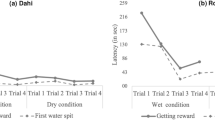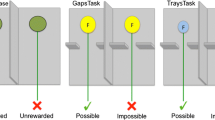Abstract
To date, neither primates nor birds have shown clear evidence of causal knowledge when attempting to solve the trap tube task. One factor that may have contributed to mask the knowledge that subjects may have about the task is that subjects were only allowed to push the reward away from them, which is a particularly difficult action for primates in certain problem solving situations. We presented five orangutans (Pongo pygmaeus), two chimpanzees (Pan troglodytes), two bonobos (Pan paniscus), and one gorilla (Gorilla gorilla) with a modified trap tube that allowed subjects to push or rake the reward with the tool. In two additional follow-up tests, we inverted the tube 180° rendering the trap nonfunctional and also presented subjects with the original task in which they were required to push the reward out of the tube. Results showed that all but one of the subjects preferred to rake the reward. Two orangutans and one chimpanzee (all of whom preferred to rake the reward), consistently avoided the trap only when it was functional but failed the original task. These findings suggest that some great apes may have some causal knowledge about the trap-tube task. Their success, however, depended on whether they were allowed to choose certain tool-using actions.




Similar content being viewed by others
References
Barth J, Call J (in press) Individual and species differences among great apes and 2.5-year old children in a series of spatial cognition tasks. J Exp Psychol Anim Behav Process
Boysen ST, Berntson GG (1995) Responses to quantity: perceptual versus cognitive mechanisms in chimpanzees (Pan troglodytes). J Exp Psychol Anim Behav Process 21:82–86
Chappell J, Kacelnik A (2002) Tool selectivity in a non-primate, the New Caledonian Crow (Corvus monoduloides). Anim Cogn 5:71–78
Chappell J, Kacelnik A (2004) Selection of tool diameter by New Caledonian crows Corvus moneduloides. Anim Cogn 7:121–127
Guillaume P, Meyerson I (1930) Recherches sur l’usage de l’instrument chez les singes. I. Le probleme du detour. J Psychol Norm Pathol 27:177–236
Köhler W (1925) The mentality of apes. Vintage Books, New York
Limongelli L, Boysen ST, Visalberghi E (1995) Comprehension of cause–effect relations in a tool-using task by chimpanzees (Pan troglodytes). J Comp Psychol 109:18–26
Mulcahy NJ, Call J, Dunbar RIM (2005) Gorillas and orangutans encode relevant problem features in a tool-using task. J Comp Psychol 119:23–32
Natale F, Potì P, Spinozzi G (1988) Development of tool use in a macaque and a gorilla. Primates 29:413–416
Povinelli DJ (2000) Folk physics for apes: a chimpanzee's theory of how the mind works. Oxford University Press, Oxford
Suda C, Call J (2004) Piagetian liquid conservation in the great apes (Pan paniscus, Pan troglodytes, and Pongo pygmaeus). J Comp Psychol 118:265–279
Tebbich S, Bshary R (2004) Cognitive abilities related to tool use in the woodpecker finch, Cactospiza pallida. Anim Behav 67:689–697
Tomasello M, Call J (1997) Primate cognition. Oxford University Press, New York
Visalberghi E, Limongelli L (1994) Lack of comprehension of cause–effect relations in tool-using capuchin monkeys (Cebus apella). J Comp Psychol 108:15–22
Visalberghi E, Tomasello M (1998) Primate causal understanding in the physical and psychological domains. Behav Process 42:189–203
Author information
Authors and Affiliations
Corresponding author
Electronic supplementary material
Orangutan in the initial phase of the study using the tool to rake the reward out. The first part of the videoclip shows a successful trial while the second part shows an unsuccessful trial. Note the attempts of the orangutan to lift the reward over the trap in the second trial.
Rights and permissions
About this article
Cite this article
Mulcahy, N.J., Call, J. How great apes perform on a modified trap-tube task. Anim Cogn 9, 193–199 (2006). https://doi.org/10.1007/s10071-006-0019-6
Received:
Revised:
Accepted:
Published:
Issue Date:
DOI: https://doi.org/10.1007/s10071-006-0019-6




